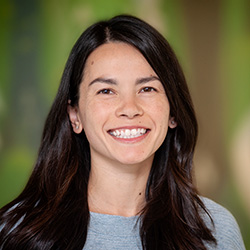Caring for Transgender Youth: A Q&A With Dr. Juanita Hodax
April 3, 2019
 Who needs to make the referral, and what happens once the referral is placed?
Who needs to make the referral, and what happens once the referral is placed?
Dr. Juanita Hodax, physician, Seattle Children’s: A patient can be referred to the Gender Clinic by one of their providers, or they can self-refer. Once a referral is placed, they will receive a call to first schedule an intake call with a social worker who is the Gender Clinic care coordinator. During the intake call, we get a brief history and discuss goals of the appointment and provide resources (for mental health providers, local community resources, etc.) that may be helpful to the patient and family even before they have their appointment. After the intake call is done, an appointment with a medical provider is made.
What ages do you see?
Dr. Hodax: We see pediatric patients up to age 21 years old. As patients approach age 21, we work with them to find an adult provider who can take over the management of their transgender care. Many times, this is a primary care provider who has some experience in transgender care.
Does a patient need parent permission to get services from the Gender Clinic, and if not, at what point does the parent need to be involved?
Dr. Hodax: While some treatments require parental consent for patients under the age of 18 years, some treatments are available to patients without formal parental consent. Gender-affirming hormones (estradiol or testosterone) do require parental consent from all parents who have medical decision-making power, because these treatments have the potential for irreversible long-term effects. Puberty blockers (Lupron injections or histrelin implant) are a reversible treatment but do require parental consent, as patients are typically at a younger age when this treatment is being considered.
Complete parental consent is not required for medications used to suppress menstrual cycles in transgender boys or for some testosterone blockers in transgender girls. Parental permission is also not required to schedule an appointment in the Gender Clinic. However, our providers and our social work team try very hard to work with parents to help them understand why treatment is important and necessary for their child.
For patients who live far away from Seattle, after their initial visit to the Gender Clinic, can they do some of their follow-up appointments and/or treatments in their local community?
Dr. Hodax: Yes! We are happy to work with primary care providers (PCPs) to allow patients to access care closer to home. If a PCP is willing to take on some of the transgender care, a patient could come to the Gender Clinic for an initial consult to discuss a plan of care, then labs can be monitored and doses adjusted by their PCP. Alternatively, a patient could come for appointments to the gender clinic every 6 to 12 months, while seeing their PCP in between appointments for laboratory monitoring and exams. This all depends on the comfort level of the PCP, their experience with transgender care and their willingness to learn.
Currently, the Seattle Children’s Gender Clinic only operates out of our Seattle clinic and Bellevue clinic. We are also starting to see Gender Clinic patients at our outreach site at the Community Medical Center in Missoula, Montana.
What’s the right age to start treatment?
Dr. Hodax: The right age to start treatment is different for each and every patient, depending on their age at presentation and desired treatments.
For patients identifying as transgender in childhood before puberty starts, there is no need for any medical intervention or treatment. Social and emotional support from parents, family, friends and healthcare providers is one of the most important aspects of care at this stage. Establishing care with a mental health provider may be beneficial. Even though medical treatments are not needed, a referral to the Gender Clinic can still be helpful to provide support and to monitor pubertal development so that treatment can be started when needed.
Puberty blockers are most beneficial when started in early puberty (Tanner stage 2) to prevent unwanted irreversible changes of the patient’s biological puberty such as breast development, voice deepening and facial hair. Puberty blockers can be started later in puberty as well but will not be able to reverse the pubertal changes that have already occurred. Puberty blockers are sometimes used after puberty as well, usually in conjunction with additional hormone treatment.
The best age for a patient to start gender-affirming hormones (estradiol or testosterone) is more variable and depends on the patient’s physical readiness, mental health readiness and family readiness. For patients who have identified as transgender early on and those who have been on a puberty blocker, we aim to start hormones at a time that is congruent with their peers if the patient is ready for them.
Resources
Seattle Children’s Gender Clinic is the only multidisciplinary clinic in our region for youth who are transgender or gender diverse. We work to create best practices for children, adolescents and young adults who are transgender and gender diverse.
Dr. Cora Breuner co-authored the first policy statement by the American Academy of Pediatrics on the subject. We base our treatments on the most current research.
Learn more about Seattle Children’s Gender Clinic.